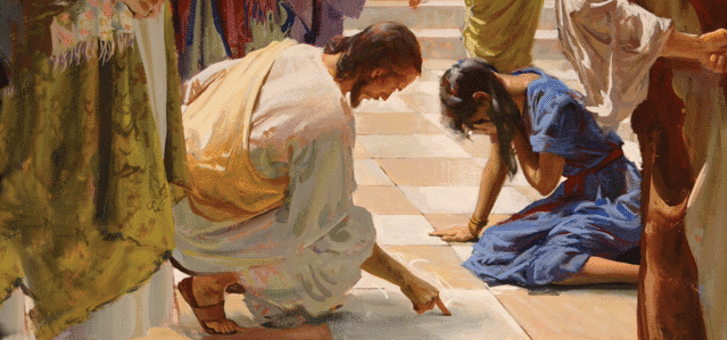I’m not sure why Hollywood hasn’t picked up on the story. It has all the makings of the kind of sex-and-romance movie that rakes in the big bucks at the box office. I’d have thought Paramount or Universal Studios would surely have turned it into a film long ago.
It began on what was probably a hot summer afternoon in ancient Jerusalem. A rather large crowd had gathered in the temple courtyard to hear Jesus teach. In my mind, I picture Him holding a child on His lap as He answers people’s questions. Suddenly, a woman’s scream pierces the air, followed by the shouts of angry male voices. The disturbance seems to be coming from the street outside the temple courtyard and of course, the people turn to see what’s going on.
A moment later, a dozen or so men burst into the courtyard, half dragging a woman toward Jesus. They throw her facedown in the centre of the crowd. You can practically smell their hostility toward her, but they’re casting dark glances at Jesus, so it’s hard to tell who’s the target of their anger.
The woman’s fingers claw the pavement. Her body shakes and she weeps quietly. Her tears form dark spots in the dust. But the men don’t give her much time for weeping. They jerk her to her feet and shove her toward Jesus. She stumbles forward, her head bowed, a hand over her face. Then she starts sinking to the ground again.
A tall man, who appears to speak for the group, grabs her arm. “Now you stand!” he orders.
“And I want you to look at Him!” He spits out the word Him.
“But Eliab,* why?” the woman pleads. “You’re the one who promised me—”
Eliab gives her another shove, then steps forward and addresses Jesus. “Sir,” he sneers, “this woman—Johanna is her name—was caught in the very act of adultery.” He pauses and looks around at the crowd and a faint smile crosses his face as he hears their murmur of astonishment. Then, fixing his eyes on Jesus, he continues, “In the Law, Moses commanded us to stone such women. What do You say?”
Jesus looks from one man to another without saying a word. They begin to fidget, avoiding His gaze, but Jesus just stands with His hands at His side.
Finally, Eliab speaks again, “Well?”
Jesus kneels and begins writing with His finger on the dusty pavement. Irritated at His apparent indifference, Eliab demands, “What’s Your verdict?”
Jesus keeps on writing.
Eliab leans toward Jesus and practically shouts his demand for an answer: “I said, ‘What’s Your verdict?’ ”
Jesus puts a hand on one knee and rises slowly to His feet. He surveys the men surrounding Him. At last, gesturing toward Johanna, who by now has fallen back on the pavement and is weeping again, He says, “Gentlemen, will the one among you who is without sin please cast the first stone?” Then He kneels and resumes writing.
No condemnation
Curious now, one of the men steps toward Jesus and looks at the writing. He leans over and turns his head so he can read the finger-traced words. Suddenly, he gasps, his neck and cheeks turning crimson, and without saying a word, hurries away. Jesus brushes His hand through the dust, erasing the lines and starts writing again. Eliab peers over Jesus’ shoulder; then he, too, grunts something inaudible and leaves. The scene is repeated till not a man remains of those who dragged Johanna into Jesus’ presence.
When all have left, Jesus stands and turns toward the frightened woman. Choking sobs come from deep within her throat and her body heaves as she weeps. She’s curled facedown on the pavement, not daring to look up both because she’s ashamed at the public exposure of her deed and because she’s terrified of her imminent fate.
Jesus steps over and rests a hand on her shoulder. “Woman,” He says gently, but she’s too deeply troubled to even be aware of His presence. He pauses a moment, then repeats, “Woman”—and this time He gives her shoulder a light shake—“woman, where are your accusers?” Jesus leaves His hand on her shoulder as He awaits her reply.
Johanna’s weeping subsides slowly, but at last she rises on one elbow, and for a moment she looks around as though in a daze. Suddenly, she jerks herself to a sitting position and gazes at the crowd that surrounds her, studying each face. At last she turns back to Jesus. “They’re all gone,” she whispers in awe. “There are no accusers!”
Jesus takes her hand and raises it slightly. For a moment, she continues to sit quietly, then slowly rises as He lifts her to her feet. “Neither do I accuse you,” He says. He leans toward her just slightly and looks into her eyes with a warm smile.
She searches His face, as if trying to understand, as though what He just said doesn’t make any sense. But slowly, as His smile and His words penetrate her mind, a light replaces the pain in her eyes. She brushes a strand of hair from her face and smiles back at Him.
Jesus reaches out with His right hand and touches her arm. “Now, go home,” He says softly, “and see to it that you don’t continue in sin.”
Old and new convenants
The old covenant was expressed to Adam and Eve in the Garden of Eden. They were told that if they obeyed by staying away from the tree of knowledge of good and evil, they would live forever; but if they disobeyed and ate from that tree, they would surely die. This covenant was ratified by the blood of animals in Exodus 24 when Moses gave the law to the people. The people said they would obey and Moses ratified the agreement with animal blood and the people went and made a golden calf. The old covenant is: obey and live, disobey and die. This covenant has no forgiving qualities. They disobeyed and they would have to die. So God offered a new covenant based upon grace. This was offered to Adam and Eve just after they sinned in the Garden. They sacrificed an animal as an expression of their faith in the coming Lamb of God (Messiah). But although the new covenant is based upon grace, it does not do away with the law, but writes it on the mind and puts it on the heart. It is written on the mind so we know what is right, and on the heart so we love what is right. - Tony Moore, In the Footsteps of Paul |
Law and grace
This story is a good illustration of the relationship between law and grace. While Jesus didn’t state either one explicitly, to the careful reader, both are obvious in what He said.
The grace part comes in Jesus’ words “Neither do I accuse you.” During the early years of Christianity, some church leaders objected to this story. They felt that Jesus’ forgiveness of the woman condoned her sin. They failed to see the law part of the story, which appears in Jesus’ words “See to it that you don’t continue in sin.” The very mention of sin implies a law. The Bible says that “sin is the transgression of the law” (1 John 3:4, KJV). The police officer couldn’t write you a speeding ticket if the state didn’t have a law against speeding.
Law and grace each have their function in our Christian lives. Law points out sin and condemns. It enforces the consequences of transgression, which in the case of God’s moral law is death (Romans 6:23; Genesis 2:16, 17). The religious leaders of Christ’s day understood this very well. They condemned the woman. However, God’s plan for the human race also includes grace. The function of grace is to pardon and restore to eternal life. The religious leaders failed to understand this.
There’s a tension between law and grace, and there will always be those who lurch into the ditch on one side or the other. Some people fear that grace will compromise law. “Grace goes easy on sin,” they say. Others fear that law will compromise grace. “Jesus died for our sins,” they say. “We no longer need the law.” But if God had done away with the law in the New Testament era, there would have been no sin for Jesus to die for.
To ignore either law or grace is to ignore the pain that is caused by sin. Law by itself leads to despair and death. Grace by itself leads to anarchy and death. In fact, there’d be no grace if there were no law. And on the other hand, law cannot save without grace.
Our Christian faith brings the two together in a wonderful harmony. The challenge of Christian living is to achieve a balance that applies both of them wisely in our relationship with God and in our relationship with others that is both firm and compassionate.




